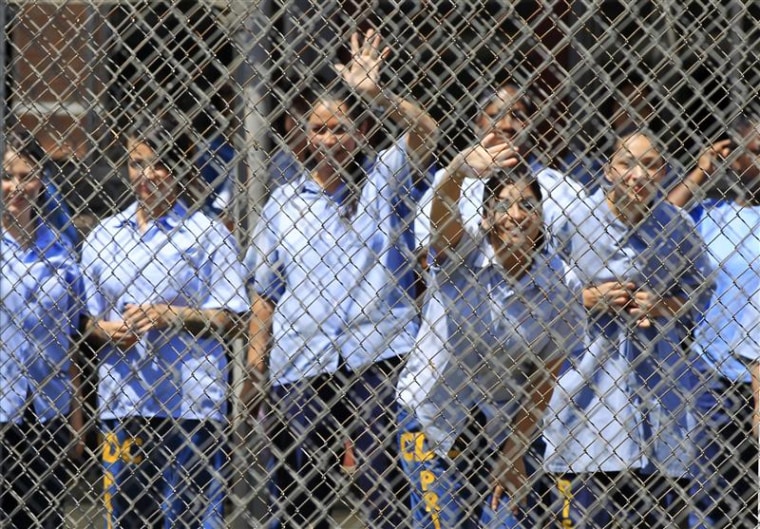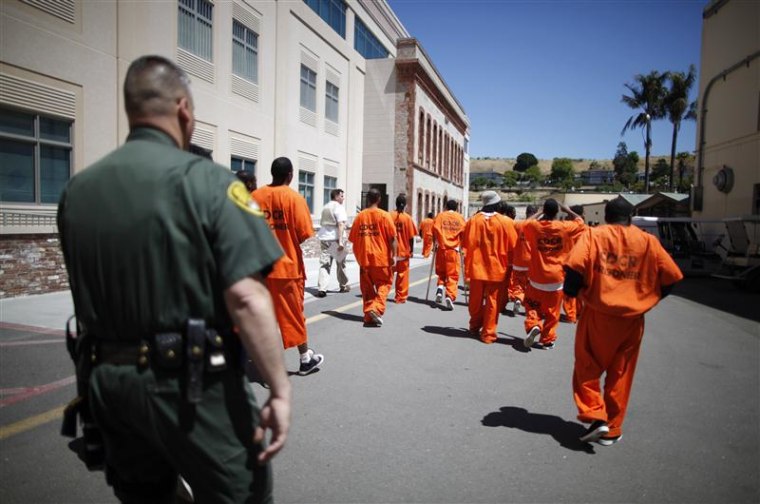More than a decade after California set a national trend toward longer sentences for habitual criminals with its three-strikes law, crime in the Golden State is down, prison costs are up - and voters are poised to soften the hardline stance.
A California ballot measure that would let some nonviolent offenders out of jail faster is the most high-profile example of what Adam Gelb, a criminal justice expert at the Pew Center, calls "a sea change across the country in attitudes on crime and punishment."
While the main financial backer of the campaign to pass the measure is a liberal billionaire, it has drawn support from religious conservatives, fiscal hawks and a broad array of constituencies who have supported "tough on crime" policies in the past.
California isn't the first state to revisit policies that have caused an explosion in inmate populations and in some cases jailed people for many decades over relatively minor infractions. In 2007, Texas faced more than $2 billion in new prison costs and chose instead to plow $240 million into alternatives such as treatment-oriented programs for nonviolent offenders.
In Delaware, Indiana, Michigan, Minnesota and New York, mandatory sentencing laws have been rolled back. Other states are revising parole standards and adding programs to let prisoners earn early release, according to a recent Pew study.
And a September 2012 study by the Council of State Governments found seven states were succeeding in cutting recidivism rates, by 6 percent to 18 percent, often by focusing on nonprison programs and treatment.
Conservative and liberal backing
California's measure is not a radical change, but sending a clear signal to legislators nationwide that it's politically safe — even smart — to embrace sentencing reform could prove especially important.
The coalition that is backing the California initiative, known as Proposition 36, illustrates the shifting politics of criminal justice. George Soros, the legendary investor who has backed many liberal causes, has donated $1 million. Conservative leader Grover Norquist, the president of Americans for Tax Reform, has endorsed it.
The Los Angeles Chamber of Commerce, the NAACP, and district attorneys of San Francisco, Los Angeles County and Santa Clara County - Silicon Valley - are all behind the proposition.
More broadly, faith-focused leaders, such as Family Research Council President Tony Perkins, are backing more cost-effective approaches to crime and punishment through groups like Right on Crime.
"Social conservatives and fiscal conservatives, for the last 30 years, have not applied the same level of scrutiny to the criminal justice area as they have applied to other levels of government," said Craig DeRoche, the former Republican Speaker of the Michigan House of Representatives who is now vice president of sentencing reform group Justice Fellowship.
Filling prisons with people who are not a threat to society is expensive and often works against integrating felons into a crime-free life, he said.
Californians are not getting soft on violent crime: Polls show that an attempt to repeal the death penalty, which is also on the November ballot, has only a slim chance of success.
Proposition 36 also is a relatively narrow adjustment to 1994's Proposition 184, known as Three Strikes and You're Out, which lengthened sentences for repeat offenders. The new proposition would let some criminals who have been in jail twice (two strikes) avoid a 25-years-to-life sentence for a third crime if it is judged to be nonviolent and nonserious.
Each side uses portraits of prisoners to make its point.
Prop 36 supporters describe Shane Taylor, who had two strikes called against him for committing two burglaries 11 days apart when he was 19. His third strike was for possession of 0.14 grams of methamphetamine, and he was sentenced to life in prison.
The California District Attorneys Association says inmate Douglas Hall shows how the system keeps dangerous, habitual criminals off the streets. Hall's strikes included a robbery during which he fired a rifle at victims and involuntary manslaughter in which he stabbed the victim 11 times, according to a report by the group. He was convicted of possessing heroin, and because it was a third strike, he was sentenced to 25 years to life. If he were resentenced under Prop 36, his maximum sentence would be seven and a half years, the DAs say.
Support in polls
Recent polls show wide and deep support for the measure, above 70 percent.
In a late-September University of Southern California/Los Angeles Times poll, 66 percent of respondents favored Prop 36. A majority of every single subgroup, divided by political party, race, family status, income, region of the state, ideology and gender favored the measure, according to the mid-September survey of 1,504 people.
Opponents of Prop 36 say voters don't understand what they are doing. District attorneys already have significant leeway to show mercy to potential third-strike offenders, and they use it, said Carl Adams, president of the California District Attorneys Association. The new law could tie their hands in pursuing long sentences for some individuals with histories of violence, he said.

The reach of the measure is limited, though; only about 2,000 of California's roughly 133,000 state prisoners would be released early if the proposition passes, according to the non-partisan Legislative Analyst's Office, which projects the state could save about $70 million to $90 million annually.
Those figures don't compare with the number of inmates who will have to be moved out of the state prison system under a court order aimed at eliminating dangerous overcrowding. The court's target is a population of 110,000 next year, down from more than 160,000 in 2006.
"California's criminal justice system is undergoing historical levels of reform," said Sarah Lawrence, a prison system policy researcher at the University of California, Berkeley, Law School.
Roughly 25,000 prisoners who would have been in state prisons will be sent instead to local jails by 2015, the state Department of Corrections says. Ideally the local authorities will be better placed to help nonviolent offenders make the transition into their communities, but many counties will struggle to afford the necessary support systems.
Crime in California, like the rest of the nation, has dropped dramatically since the early 1990s. State violent crimes are down by more than half and homicides by nearly two-thirds since 1992. Harsher sentencing was probably part of the reason, Lawrence said, but a lot of the most dangerous folks are now behind bars, and there may be better ways to raise public safety.
"Your bang for the buck goes down the wider you make the net," she said.
If Californians use the ballot box to say they want their state to try to find smarter ways to deal with prisoners, others will listen, said Pew's Gelb. "Precisely because California's three-strikes law is so notorious, any changes in that law will reverberate around the country."
